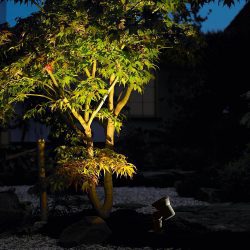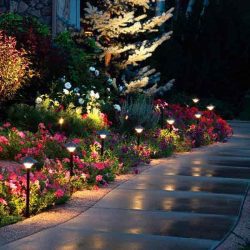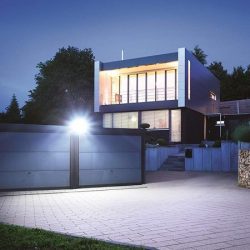Landscape lighting is one of the best ways to add variety, value, safety, and security to your landscape. If you’re thinking of ideas for how to illuminate your own landscape, here’s a list of our top tips so you can ensure you’ve thought of everything before beginning your project.
Goals of Landscape Lights
Because there are many different types of landscape lights – all of which provide different lighting and shadowing effects – it’s important to consider your goals when planning your installation. Ask yourself:
- Are you planning to highlight a particular plant or feature in your garden?
- If so, how many features are you hoping to highlight?
- If I put lights here, will they cast shadows in the right places?
- Do I have a pathway. Staircase, or patio you want lit?
- Do I want your lights low on the ground or high in the trees?
- If I install this light here, will it shine through any bedroom windows? Will it disturb my neighbours?
Once you’ve answered all these questions, you should be able to make decision on what types of lights are best suited for your needs!

Types of Landscape Lighting
Up Lighting
Up lighting usually consists of lights placed at the base of trees and walls to highlight shapes and textures. This is effective either to draw focus toward particular features of your garden, or at the back of your landscape to create a ‘wall’ of soft light in a defined space.
Down Lighting
Down lighting usually refers to lights that have been placed in trees or on poles to highlight large portions of the landscape. This is a good way to cast even lighting all over your landscape for nighttime visibility that feels warm and natural.
Shadowing
Shadowing involves lighting a landscape feature not as a means of highlighting, but for the unusual shadows it can create. Certain plants and planting arrangements, when planted next to a wall or solid surface, can be lit up in such a way that casts unique, sweeping patterns across walls and fences, resulting in a distinct and vibrant visual effect.
Backlighting
Also known as silhouette lighting, back lighting involves putting lights directly behind shrubs and trees that feature unusual shapes and textures (such as Japanese maples, ornamental, arbutus, and topiaries and bonsais) with the intention of creating eye-catching silhouettes and deep, long shadows.
Path Lights
Path lights are generally short, downward-pointing lights that line either side of a pathway, sidewalk, or driveway. Though they’re likely installed with safety in mind, they can nonetheless function as valuable accents to any landscape.
Floodlights
Floodlights are larger and brighter than most landscape lights, and are therefore generally installed as security or safety lights. However, if your landscape is large and open, floodlights may be an idea choice for providing even lighting that originates from one source.
Water Lights
Water lights are designed to be installed in or around your water feature to light up streams, waterfalls, fountains, and pools. When placed underwater, it can also create shadowing effects on the surrounding areas.
Patio, Stair, and Deck Lights
These lights can be built right into the deck boards, patios, and the runners of staircases, subtly lighting your yard in ways that that aid with safety and look great.
Why add Landscape Lights?
Whether you’re adding thirty spotlights to help highlight your plants, or you’re simply installing two low voltage lights for nighttime safety, lights on your property are a worthwhile investment that helps cultivate feelings of warmth and fun.
For many, adding low-voltage lighting to a landscape seems like a needless luxury, but that’s far from the truth! Residents and homeowners who choose to add lighting to their landscape know that it provides more than just light.
If designed and installed properly, lights can help turn an otherwise dark, non-functional area into a nighttime oasis that highlights plants and boulders to create striking displays. This impact has the ability to cultivate unique and inimitable feelings and memories.
In other words – having landscape lights installed isn’t just an addition to your landscape; it’s an improvement to your lifestyle.
Want to Light Up your Landscape?
No matter what kind of landscape lighting you’re thinking of installing, we always recommend consulting with an expert first.
While many of the principles of landscape lighting seem straightforward, installation and design can be a little more complicated!
Para Space’s landscape services division has experienced designers and installers, and we can help you come up with excellent lighting solutions if you need support. Get in touch for more details!











Comments are closed here.